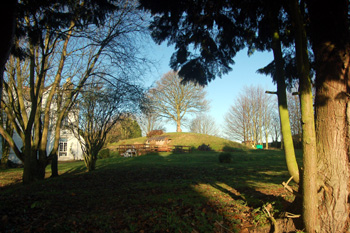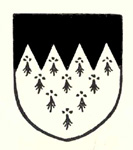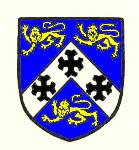Tilsworth Manor

Warren Knoll December 2008
Domesday Book of 1086
In 1086 William Peverel held Tilsworth Manor from King William I, his tenant being one Ambrose. The manor contained ten hides, ten villagers, six smallholders and three slaves - a total of nineteen. To reach a truer figure for the population of the manor one needs to multiply this number by at least four to allow for these men's dependents, giving a total hypothetical population of around eighty, by no means the smallest in the county.
The manor also contained woodland for a hundred pigs about which the entry reads, somewhat cryptically: "Oswy took away this woodland; the Hundred states that it lay in this manor before 1066". In 1066 Osmund, a thegn of King Edward the Confessor held the manor and in had been worth £10, by the time of Peverel's take-over this had sunk to £4 but had recovered a little to £6 by 1086.

Morteyn family coat of arms
Tilsworth Manor
By 1284 the overlordship of the manor has passed from the Peverel to the Morteyn family , William Morteyn being overlord. By 1346 the overlordship was in the hands of the Mowbray family. By 1408 the overlord was Andrew Brown, the last known commoner overlord as later documents state that the tenant held the manor directly from the Crown. Warren Knoll, just behind the former vicarage, is a Norman motte, and possibly a bailey, the site of a small wooden castle which was presumably the seat of the manor immediately after the conquest.
By the middle of the 13th century the tenant of the Manor, who had been Ambrose in 1086, was John Morteyn, who held it from Eustace Morteyn, the then overlord. The Morteyns continued to hold the manor until John Morteyn died childless in 1373 when it passed to his cousin Richard Chamberlain. The Chamberlains then held the manor until the early 16th century. Edward Chamberlain seems to have alienated the manor to his grandfather Sir Richard Fowler, as he died owning it in 1528. Another Richard Fowler was tried for treason in the court of Star Chamber in 1600. His wife and her lover, together with Fowler's brother-in-law had forged a letter implicating him in a plot to poison Elizabeth I.

Fowler family coat of arms
The Fowler family had the manor until 1606 when another Richard Fowler sold it to Anthony Chester, who became a baronet in 1619. It is during this century that it seems the manor house was rebuilt. This family then held the manor until 1755 when Charles Bagot Chester died and left the manor to his cousin Charles Bagot on the condition that he took the name Chester. Certainly by the 17th century the manor house had become a farm house for Manor Farm. In 1838 the manor was sold to Sir Gregory Osborn Page-Turner of Battlesden in whose family it remained into the 20th century. In the early 1920s a succession of laws of property acts abolished copyhold tenure leaving the Lord of the Manor nothing but an empty title.